Sino-American Building Energy Standards Comparison and Recommendations towards Zero Energy Building
Abstract
:1. Introduction
2. Generalization of Standards in Two Countries
2.1. Update and Improvement Process
2.2. Higher Development Goals and Related Work
3. Building Energy Standards in China
3.1. Energy-Saving Milestones in China
3.2. Current Building Energy Standards System
3.3. Implementation and Efficiency of Energy Savings
4. Building Energy Efficiency Standards in America
4.1. ASHRAE and ANSI
4.2. Main Building Energy Standards and Codes
4.3. ASHRAE 90.1 Implementation
5. Comparison of Standards Content
5.1. Qualitative Comparison
5.1.1. Standard Systems and Characteristics
5.1.2. Chapters Framework
5.2. Quantitative Comparison
5.2.1. Building Envelope Requirements
- (1)
- In terms of U value of roof, both countries gradually decreased the U value from south to north, and restrictions in China’s cold regions are decreased by 40–77.8% compared to those in hot summer and warm winter regions; ASHRAE 90.1-2019 is 33–50% lower than the limit of the 2010 version. The limit of the Chinese joint construction energy saving standard is higher than ASHRAE 90.1, and the limit of the energy saving standard in residential buildings in hot summer and warm winter, hot summer and cold winter and cold areas is also higher than ASHRAE 90.1-2019;
- (2)
- As for the U value of wall above the ground, the limit value has also decreased significantly from south to north (except for residential buildings located in hot summer and cold winter climate in China). ASHRAE 90.1 decreased the U value of wall by about 42.8–55%, while China decreased it by about 50%. The limit requirements of ASHRAE version have few changes and the limits of energy efficiency standards for public buildings in Chinese climate regions and residential buildings in severe cold regions are lower than ASHRAE 90.1-2019;
- (3)
- As for the R value of the below ground wall, energy standards in both countries set only limit requirements for cold and severe cold areas, which are gradually increasing from south to north. The limit value of severe cold regions in the USA increased by about 30.7–50%, and that of China increased by about 33% compared to the values of cold regions. ASHRAE 90.1-2019 is about 38.4–50% higher than the 2016 version limit. The limits in Chinese standards are lower than ASHRAE 90.1-2019 for public buildings; but higher than ASHRAE 90.1-2019 for residential buildings in sever cold regions.
- (4)
- As for the U value of floor, ASHRAE sets limits for all climate zones, while Chinese standards set limits only for public buildings in cold and severe cold regions, and for residential buildings in hot summer and cold winter regions, and cold and severe cold regions. The limit values in ASHRAE decreased by 40.1% and 52.4% for public and residential buildings, respectively, from the 2010 to 2019 version, while those in China decreased by 80% for residential buildings from the hot summer and cold winter region to the severe cold region. China’s standard limits on public buildings are similar to ASHRAE, but those on residential buildings are much higher (from 73.3% to 80.3%) than ASHRAE.
5.2.2. HVAC System Energy Efficiency Limits
6. Results and Discussions
6.1. Comparative Analysis of Content
- (1)
- China and the USA have made great progress in building energy standards with a gradual improvement in the energy saving goals of 75% and 62.4%, respectively, compared to building energy consumption baseline in 1980;
- (2)
- Building envelope parameters in ASHRAE 90.1-2019 have more stringent regulations than those of China building energy standards except for the wall above ground, while HVAC efficiency parameters requirements are close.
- (3)
- China features more effective actual implementation across the nation, while ASHRAE 90.1 has not been adopted in any states in the USA by the end of 2020, most states still adopt ASHRAE 90.1-2009 and 2013 versions, which are much older than the latest version.
- (4)
- China has already taken actions to establish and issue a mandatory technical standard for nearly zero and zero energy buildings, covering definitions, key envelope and energy-related parameter requirements, energy-saving goal and device efficiency regulations, while the USA has established only voluntary instruction of AEDG series for zero energy buildings mainly focused on initial design.
6.2. Crucial Factors for Real Energy Saving Efficiency
- (1)
- Implementation of the design stage: establishing the goal of energy saving
- (2)
- Implementation of the construction stage: energy saving potential
- (3)
- Building energy consumption statistics: actual energy-saving efficacy
- (4)
- Standards upgrade: a new energy saving goal
6.3. Recommendations for Future Development
- (1)
- Standards improvement
- (a)
- China’s building energy standard system should be reformed into a more concise pack of “1 Mandatory + 1 Higher purpose”. This would stipulate building energy saving requirements for all building types in different climate zones in a single standard, while boost the development of zero energy buildings through technical standards for nearly zero and zero energy buildings;
- (b)
- Requirements of key parameters and energy saving goals should be improved according to the future building energy conservation trends. Technical strategies, such as passive building design, active energy technology and the use of renewable energy, should be in focus; and
- (c)
- Requirements for the use of renewable energy should be itemized and regulated, including solar, wind, hydrogen and geothermal energy. Related renewable energy technologies such as energy storage, PV generation, distributed energy system and multi-energy complementation must be stipulated by key parameters requirements and technical paths.
- (2)
- Implementation of design and construction stages
- (d)
- Strict regulations on the implementation of standards should be guaranteed by potent governmental legislation on energy saving laws and regulations and provision of technical support and service in the building energy saving research and application; and
- (e)
- By establishing an effective supervision mechanism during the actual construction process, ineligible building projects that do not comply with the requirements of energy standards in buildings should be immediately rectified or halted if necessary. Buildings that fall out of the energy standards stipulation should never be built.
- (3)
- Direction of standards upgrade
- (f)
- Zero energy building should be the ultimate goal of energy conservation in buildings under the urgent dual targets of carbon peak and neutralization. Therefore, the technical standard of ultra-low, nearly zero and zero energy buildings must be imperatively promoted throughout the country and gradually enforced according to the building energy consumption trend estimated for the institutional guarantee of carbon peak in 2030 and neutralization in 2060.
7. Conclusions
- (1)
- China and the USA have made great progress in building energy standards with a gradual improvement in the energy saving goals of 75% and 62.4%, respectively, compared to building energy consumption baseline in 1980;
- (2)
- At present, China’s building energy standards have a greater improvement in energy savings, along with a more intact standard system and a stratified upgrading pathway towards enforced standards, national standards and zero energy building standards. National standards comprehensively match different climate zones for different building types;
- (3)
- More efficient implementation of building energy standards in China has realized a greater energy saving potential by lowering building energy intensity, and thus a substantial reduction in building energy consumption, while in the USA most states still adopt ASHRAE 90.1-2009 and 2013 versions, which are much older than the latest version in 2019. However, by the end of 2020, ASHRAE 90.1-2019 has not yet been adopted;
- (4)
- China has already taken actions to establish and issue a mandatory technical standard for nearly zero and zero energy buildings, while America only established a voluntary instruction of AEDG series for zero energy building;
- (5)
- In the future, China should add new technical content to the building energy standards aimed at regulating the use of renewable energy based on key parameters and related technology, while reinforcing efficient implementation during the construction stage trough strong governmental legislation and a supervision mechanism; and
- (6)
- Future energy saving goals in building energy standards must be set with the ultimate purpose of China’s carbon peak and neutralization target in 2030 and 2060, respectively, according to the actual trend of building energy consumption under the real influence of the implementation of building energy standards. Zero energy buildings will be the final goal in the building energy conservation industry that can be realized through the gradually applied building standards for ultra-low, nearly zero, and zero energy buildings in the next 30 years.
Author Contributions
Funding
Institutional Review Board Statement
Informed Consent Statement
Conflicts of Interest
Abbreviations
| GB50189 | Design standards for energy efficiency of public buildings |
| JGJ26 | Design standards for energy efficiency of residential buildings in sever cold and cold regions |
| JGJ134 | Design standards for energy efficiency of residential buildings in hot summer and cold winter regions |
| JGJ75 | Design standards for energy efficiency of residential buildings in hot summer and warm winter regions |
| GB/T51350 | Technical standard for nearly zero energy buildings |
| ASHRAE 90.1 | Energy Standard for Building Except Low-Rise Residential Buildings |
| IECC | International Energy Conservation Consultants |
| ASHRAE | American Society of Heating, Refrigerating and Air-Conditioning Engineers |
| AEDG | Advanced Energy Design Guides |
| HSWW | Hot summer and warm winter regions |
| HSCW | Hot summer and cold winter regions |
| GHG | Green house gas |
References
- Bui, D.K.; Ngoc, N.T.; Abdalaah, G.; Ngoc-Tri, N.; Duc, N.T. Enhancing building energy efficiency by adaptive facade: A computational optimization approach. Appl. Energy 2020, 265. [Google Scholar] [CrossRef]
- Bierwirth, P. Carbon Dioxide Toxicity and climate Change: A Serious Unapprehended Risk for Human Health; Australian, National University: Canberra, ACT, Australia, 2020. [Google Scholar]
- Bei, H.; Jiao, L.; Song, X.; Shen, L.; Xiong, B. Country Review on the Main Building Energy-Efficiency Policy Instrument. In Proceedings of the 19th International Symposium on Advancement of Construction Management and Real Estate; IEEE: New York, NY, USA, 2015; pp. 379–396. [Google Scholar]
- Leite, F.; Yamin, F. Roadmap to Zero Emission; UNFCCC: Bonn, Germany, 2014. [Google Scholar]
- Visscher, H.J.; Mejer, F. Energy saving goals require reform of building regulations and control. Energy Econ. 2011, 381–390. [Google Scholar]
- Zhang, L.; Jin, M.; Liu, J.; Zhang, L. Simulated study on the potential of building energy saving using the green roof. Procedia Eng. 2017, 205, 1469–1476. [Google Scholar] [CrossRef]
- Salem, R.; Bahadori-Jahromi, A.; Mylona, A. Investigating the impacts of a changing climate on the risk of overheating and energy performance for a UK retirement village adapted to the nZEB standards. Build. Serv. Eng. Res. Technol. 2019, 40, 470–491. [Google Scholar] [CrossRef]
- Salem, R.; Bahadori-Jahromi, A.; Mylona, A.; Godfrey, A. Nearly-Zero Energy Buildings: Retrofitting to Meet the Standard; University of West London: London, UK, 2020. [Google Scholar]
- Salem, R.; Bahadori-Jahromi, A.; Mylona, A.; Bohdanowicz, P. Energy performance and cost analysis for the nZEB retrofit of a typical UK hotel. J. Build. Eng. 2020, 31, 101403. [Google Scholar] [CrossRef]
- Gu, L.; Zhang, Y.R.; Wang, Y.F. Comparison of energy efficiency standards in the public building of China, the US, the UK. Adv. Mater. Res. 2013, 869–870, 389–392. [Google Scholar] [CrossRef]
- Caunesil, C.; Callies, M.; Zmeureanu, R.; Roux, J.-J. Comparison of Two Building Energy-Related Standards: MNEECH (Canada) and RT2000 (France). In Proceedings of the 16th CIB World Building Congress, Toronto, ON, Canada, 27–30 June 2004. [Google Scholar]
- Madsen, M.; Jana, J.J.B. ASHRAE 90.1. Buildings(2002).Book. Available online: https://search.ebscohost.com/login.aspx?direct=trueu0026db=buhu0026AN=5877121u0026site=ehost-live (accessed on 3 September 2021).
- Ferguson, S.J.A. Aligning IECC and Standard 90.1; ASHRAE: Corners, GA, USA, 2014. [Google Scholar]
- Hong, T.; Li, C.; Yan, D.J.E.P. Updates to the China design standard for energy efficiency in public buildings. Energy Policy 2015, 87, 187–198. [Google Scholar] [CrossRef] [Green Version]
- Zhang, S.; Qiu, Y. Study on Comparison of Public Building Energy Codes and Standards between Foreign Countries and China; Springer: Berlin/Heidelberg, Germany, 2015. [Google Scholar]
- Zou, Y.; Hong, T.; Li, C.; Zhang, Q.; An, Q.; Hu, S. Development and prospects for China’s building energy efficiency standards. Energy Build. 2016, 32, 1–5. [Google Scholar]
- Fayaz, R.; Kari, B.M.J.A.E. Comparison of energy conservation building codes of Iran, Turkey, Germany, China, ISO 9164 and EN 832. Appl. Energy 2009, 86, 1949–1955. [Google Scholar] [CrossRef]
- Lin, G.; Hong, T.; Li, C.; Zhang, Q.; An, Q.; Hu, S. Comparison of building energy efficiency standards of China and some developed countries. Energy Build. 2014, 143. [Google Scholar] [CrossRef] [Green Version]
- Puhua, Y.; Jian, T. Comparison of building energy efficiency standards between China and the United States. J. Central China Archit. 2015, 41, 36–42. [Google Scholar]
- Bin, L. Comparative Study on Design Standards of Building Energy Efficiency between China and the United States; Huazhong University of Science and Technology: Wuhan, China, 2015. [Google Scholar]
- Thornton, B.; Rosenberg, M.; Richman, E.; Wang, E.; Xie, Y.; Zhang, J.; Cho, H.; Mendon, V.V.; Athalye, R.A.; Liu, B. Achieving the 30% Goal: Energy and Cost Savings Analysis of ASHRAE Standard 90.1-2010. 2011. Available online: https://www.energycodes.gov/sites/default/files/documents/BECP_Energy_Cost_Savings_STD2010_May2011_v00.pdf (accessed on 3 September 2021).
- Zhang, S.; Sven, S.; Hermelink, A.; Boermans, T.; Pagliano, L.; Zangheri, P.; Armani, R.; Voss, K.; Musall, E. International Building Energy Efficiency Standards Research; UNFCCC: Bonn, Germany, 2013; pp. 8–14. [Google Scholar]
- Halverson, M.; Rosenberg, M.; Richman, E.; Wang, E.; Xie, Y.; Zhang, J.; Cho, H.; Mendon, V.V.; Athalye, R.A.; Liu, B. ANSI/ASHRAE/IES Standard 90.12010 Final Determination Quantitative Analysis. 2011. Available online: https://www.energycodes.gov/sites/default/files/documents/BECP_FinalQuantitativeAnalysisReport901-2010Determination_Oct2011_v00.pdf (accessed on 3 September 2021).
- Halverson, M.; Rosenberg, M.; Richman, E.; Wang, E.; Xie, Y.; Zhang, J.; Cho, H.; Mendon, V.V.; Athalye, R.A.; Liu, B. ANSI/ASHRAE/IES Standard 90.1-2013 Determination of Energy Savings: Qualitative Analysis; ASHRAE: Corners, GA, USA, 2014. [Google Scholar]
- Guo, W.; Hong, T.; Li, C.; Yan, D.; Zhang, Q. Current building energy efficiency standard system in China. Energy Build. 2013, 9, 61–65. [Google Scholar]
- Zhao, S.; Feng, W.; Zhang, S.; Hou, J.; Zhou, H.; Levine, M.D. Energy savings and cost-benefit analysis of the new commercial building standard in China. Procedia Eng. 2015, 121, 317–324. [Google Scholar] [CrossRef]
- Hale, E.T.; Macumber, D.L.; Long, N.L.; Griggith, B.T.; Benne, K.S.; Pless, S.D.; Torcellini, P.A. Technical Support Document: Development of the Advanced Energy Design Guide for Medium Box Retail-50% Energy Savings; NREL: Golden, CO, USA, 2008. [Google Scholar]
- Office of Energy Efficiency and Renewable Energy. Energy Savings Analysis; ANSI/ASHRAE/IES Standard 90.1-2016; ASHRAE: Corners, GA, USA, 2017. [Google Scholar]
- Kim, H.; Liu, Z.; Baltazar, J.C.; Haberl, J.; Culp, C.; Yazdani, B.; Montgomery, C. Recommendations for 2009 IECC 15% above Code Energy Efficiency Measures for Residential Buildings; Texas A&M University Libraries: Texas, NV, USA, 2010. [Google Scholar]
- DOE. State Code Adoption Tracking Analysis. US Department of Energy, Energy Efficiency & Renewable Energy, Building Energy Codes Program. 2019. Available online: https://www.energycodes.gov/state-code-adoption-tracking-analysis (accessed on 3 September 2021).
- Boldt, J.; Leed, A.P. What’s New in ASHRAE 90.1-2013. Consulting-Specifying Engineer. 19 January 2014. Available online: https://www.researchgate.net/publication/296448603_What’s_new_in_ASHRAE_901-2013 (accessed on 3 September 2021).
- Schwedler, P.M.; Hydeman, M.; Skalko, S.; Ahmed, J.; Amrane, K.; Anis, W.; Anderson, S.; Arbore, A.; Baselici, P.; Blanchette, R.; et al. ASHRAE Standard 90.1; ASHRAE: Corners, GA, USA, 2010. [Google Scholar]
- Goel, S.; Rosenberg, M.; Eley, C. ANSI/ASHRAE/IES Standard 90.1-2016 Performance Rating Method Reference Manual; ASHRAE: Corners, GA, USA, 2017. [Google Scholar]
- Zhang, S.; Fu, Y.; Yang, X.; Xu, W. Assessment of mid-to-long term energy saving impacts of nearly zero energy building incentive policies in cold region of China. Energy Build. 2021, 241, 110938. [Google Scholar] [CrossRef]
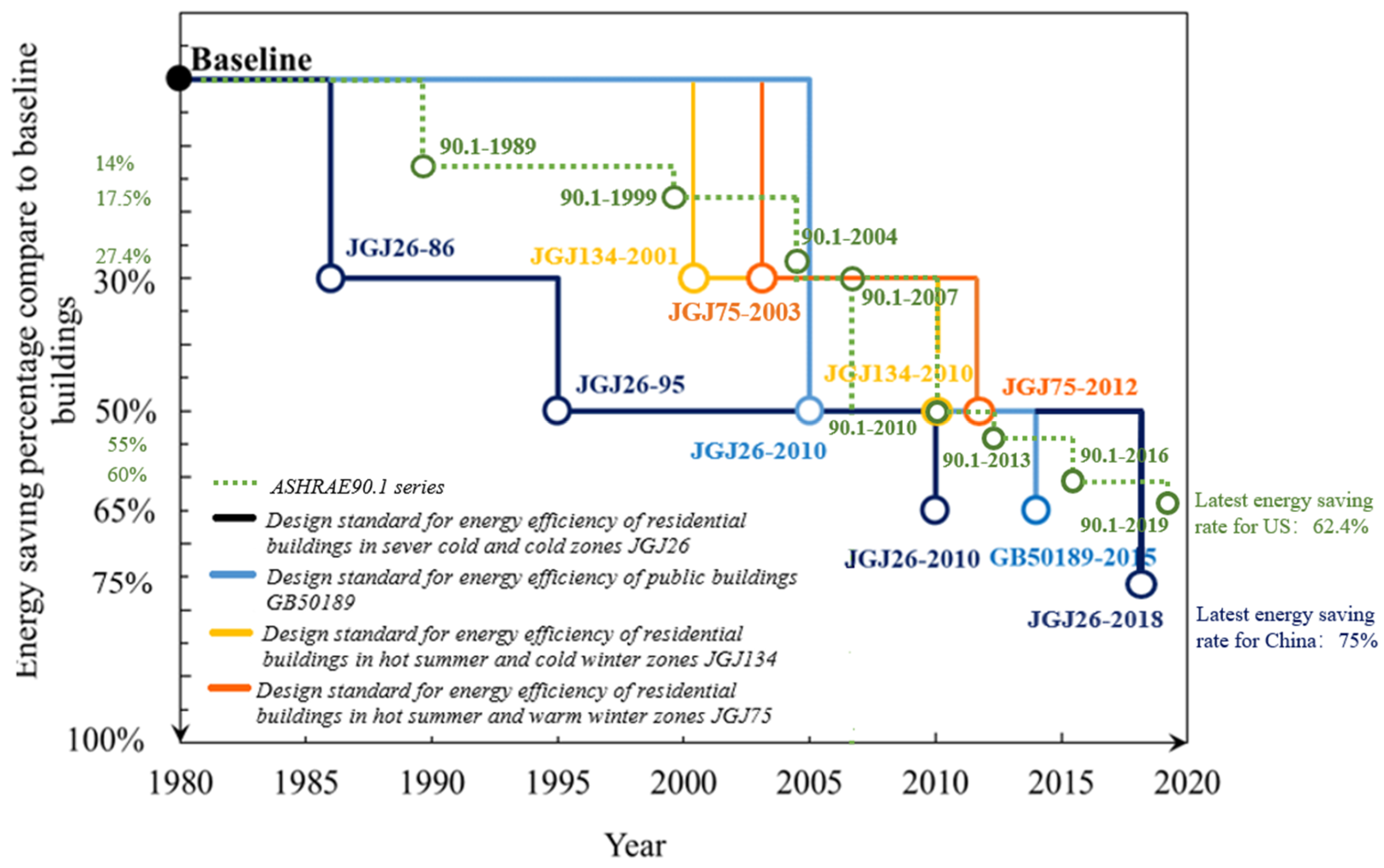

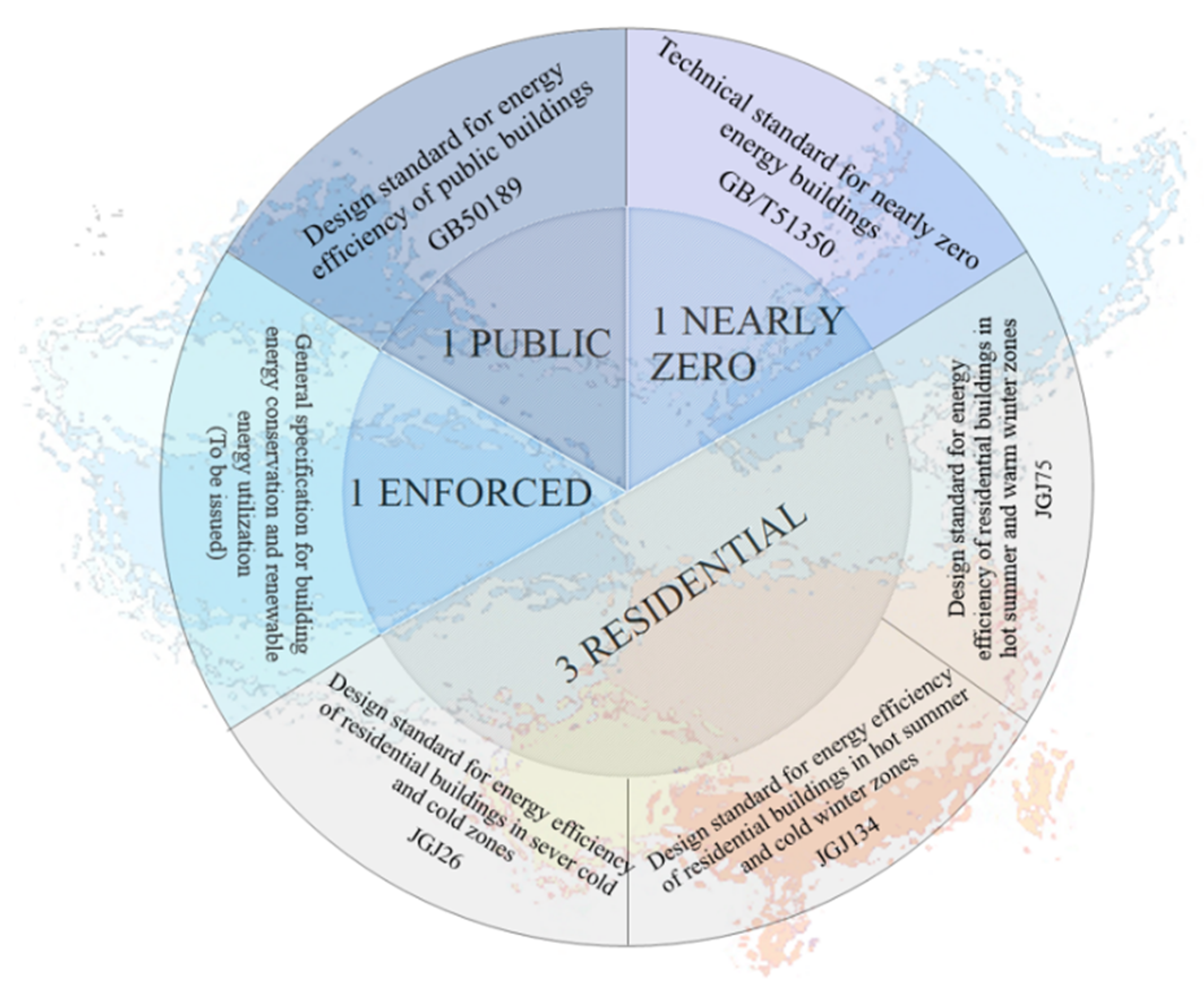
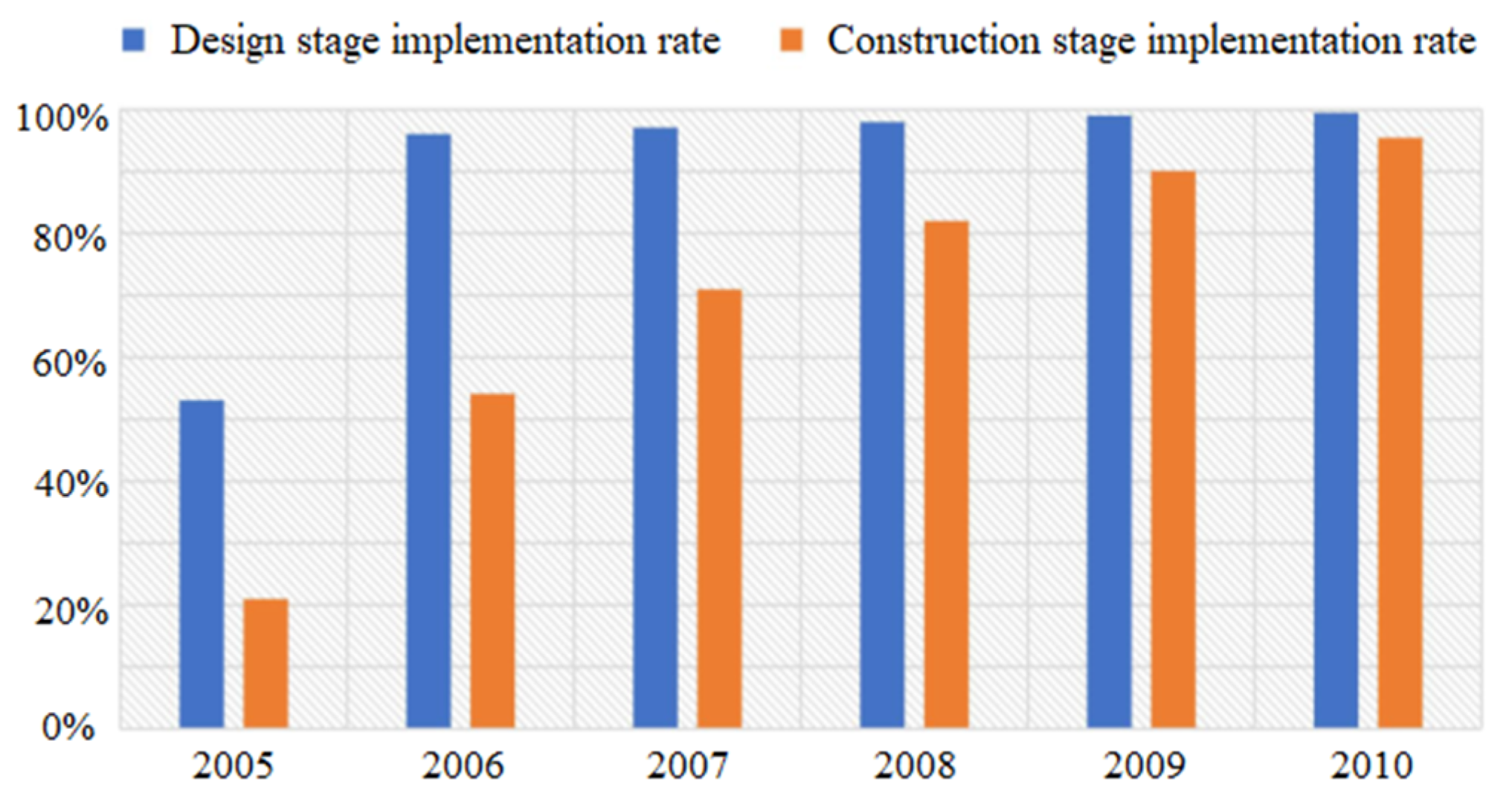





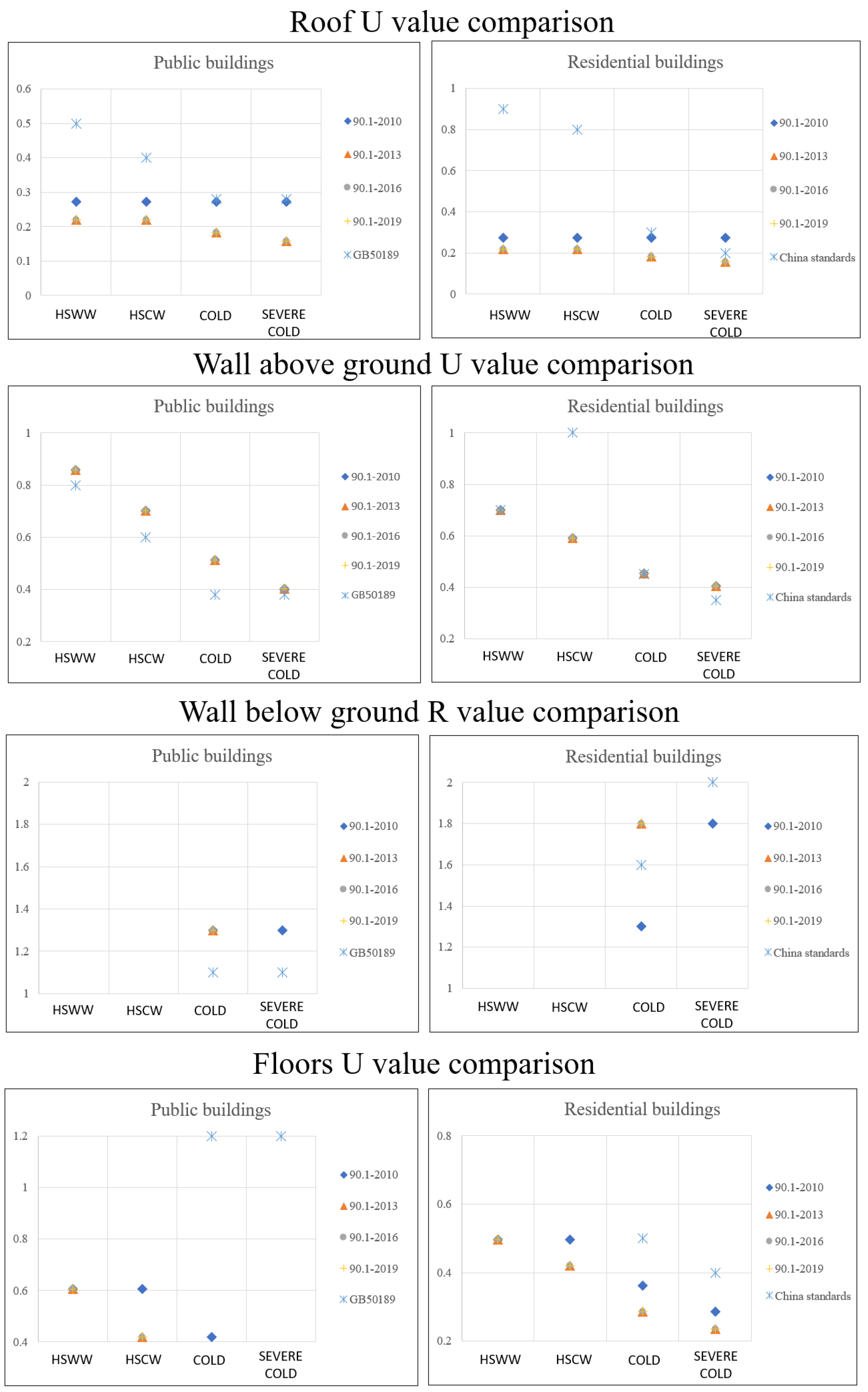
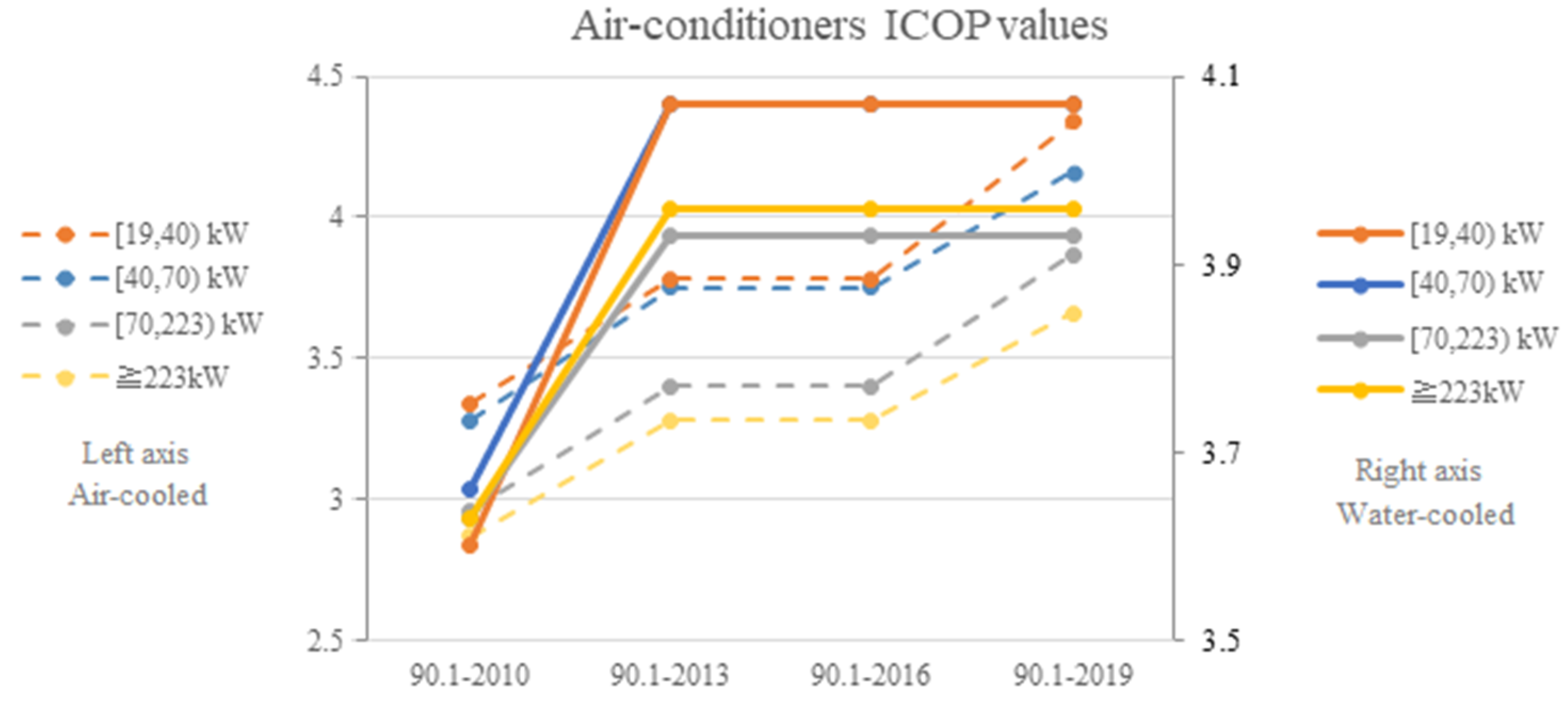
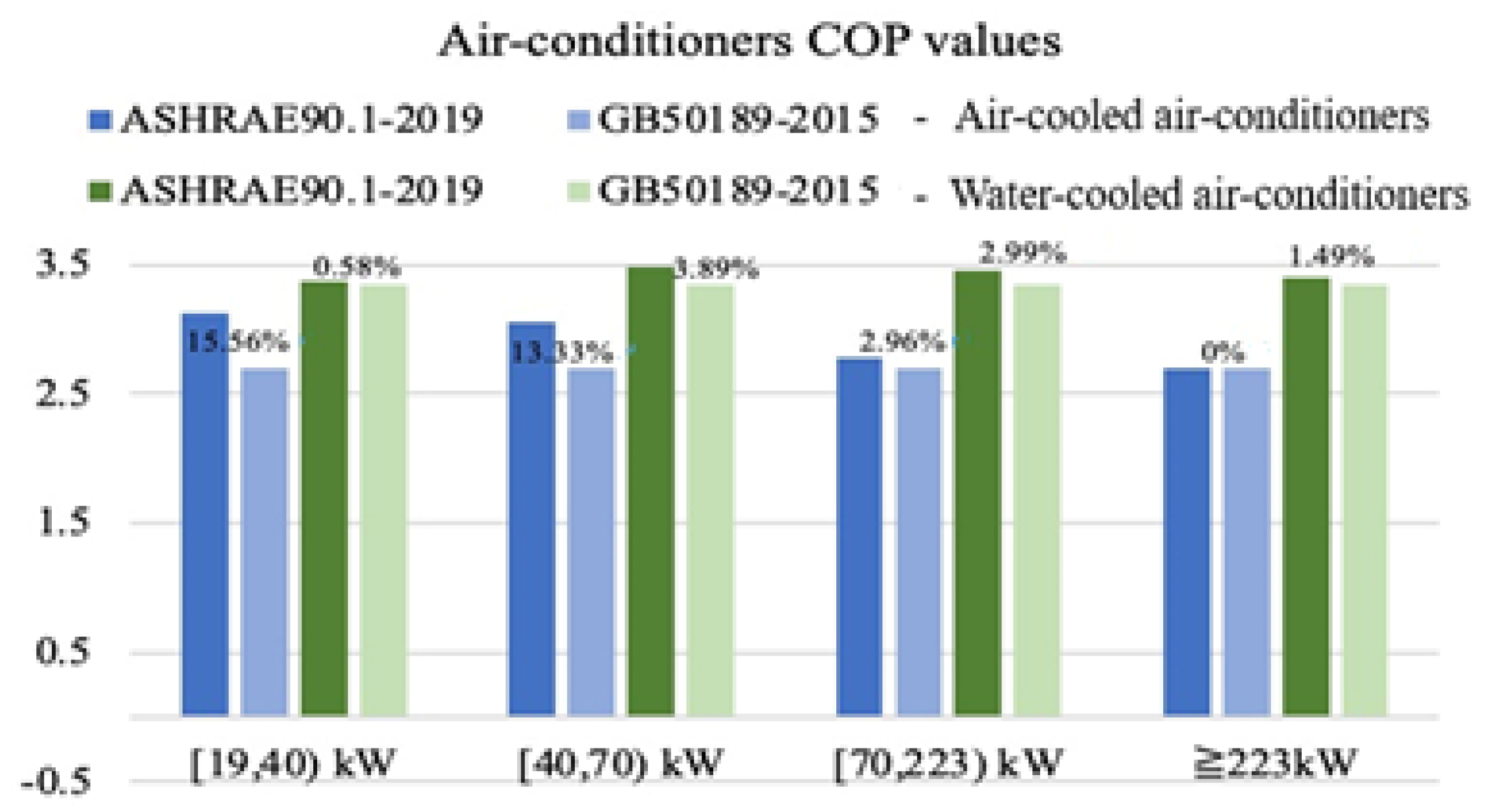

| ASHRAE 90.1 Series | Categories | HVAC Equipment and Systems | |||
|---|---|---|---|---|---|
| 2019 | 2016 | 2013 | 2010 | 6.8.1A | Electrically operated air conditioners and condensing units |
| 6.8.1B | Electrically operated unitary and applied heat pumps | ||||
| 6.8.1C | Water chilling packages | ||||
| 6.8.1D | Electrically operated packaged terminal air conditioners, packaged terminal heat pumps, single-package vertical air conditioners, single-package vertical heat pumps, room air conditioners and room air conditioner heat pumps | ||||
| 6.8.1E | Warm air furnaces and combination warm air furnaces/air-conditioning units, warm air duct furnaces and unit heaters | ||||
| 6.8.1F | Gas and oil-fired boilers | ||||
| 6.8.1G | Heat rejection equipment | ||||
| 6.8.1H | Heat transfer equipment | ||||
| 6.8.1I | Variable flow air conditioners | ||||
| 6.8.1J | Variable refrigerant flow air-to-air and applied heat pumps | ||||
| 6.8.1K | Air conditioners and condensing unit serving computers rooms | ||||
| 6.8.1-12 | Commercial refrigerator and freezers | ||||
| 6.8.1-13 | Commercial refrigeration | ||||
| 6.8.1-14 | Vapor compression based indoor dehumidifiers | ||||
| 6.8.1-15 | Electrically operated DX-DOAS Units, single-package and remote condenser, without energy recovery | ||||
| 6.8.1-16 | Electrically operated DX-DOAS Units, single-package and remote condenser, with energy recovery | ||||
| 6.8.1-17 | Electrically operated water source pumps | ||||
| HVAC Equipment | Parameters Requirements | |||
|---|---|---|---|---|
| GB50189-2015 | JGJ26-2018 | JGJ134-2010 | JGJ75-2012 | |
| 1. Solar energy utilization system | Efficiency of heat collecting system | - | ||
| 2. Heating boiler | Rated evaporation and thermal efficiency | Thermal efficiency of various boilers under nominal conditions | Thermal efficiency of household gas heating water heater | - |
| Thermal efficiency of household gas-fired heating boiler | ||||
| 4. Electric driven steam compression circulating water chiller | Total installed capacity COP | |||
| IPLV | EER | EER | ||
| 5. Air-conditioning system | electric cooling source IPLV | |||
| 6. Air-conditioning unit | EER | EER (>7100 w) | EER (>7100 w) | |
| 7. Air-source heat pump unit | COP | COP (heating condition) | ||
| 8. Distributed room air conditioner | EER | EER | ||
| 9. Multi connected air conditioning (heat pump) unit | IPLV | IPLV | IPLV(C) | IPLV |
| 10. Direct fired LiBr absorption chiller | Performance parameter | EER | EER | |
Publisher’s Note: MDPI stays neutral with regard to jurisdictional claims in published maps and institutional affiliations. |
© 2021 by the authors. Licensee MDPI, Basel, Switzerland. This article is an open access article distributed under the terms and conditions of the Creative Commons Attribution (CC BY) license (https://creativecommons.org/licenses/by/4.0/).
Share and Cite
Fu, Y.; Zhang, S.; Chen, X.; Xu, W. Sino-American Building Energy Standards Comparison and Recommendations towards Zero Energy Building. Sustainability 2021, 13, 10050. https://doi.org/10.3390/su131810050
Fu Y, Zhang S, Chen X, Xu W. Sino-American Building Energy Standards Comparison and Recommendations towards Zero Energy Building. Sustainability. 2021; 13(18):10050. https://doi.org/10.3390/su131810050
Chicago/Turabian StyleFu, Yijun, Shicong Zhang, Xi Chen, and Wei Xu. 2021. "Sino-American Building Energy Standards Comparison and Recommendations towards Zero Energy Building" Sustainability 13, no. 18: 10050. https://doi.org/10.3390/su131810050
APA StyleFu, Y., Zhang, S., Chen, X., & Xu, W. (2021). Sino-American Building Energy Standards Comparison and Recommendations towards Zero Energy Building. Sustainability, 13(18), 10050. https://doi.org/10.3390/su131810050






